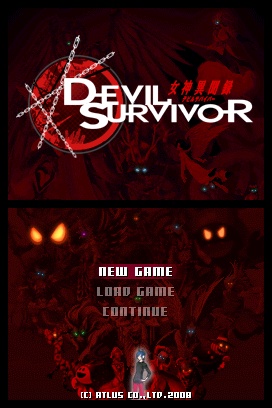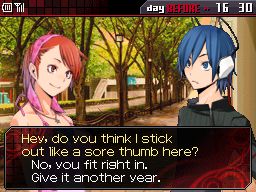Introduction
 Title screen.
Title screen.Devil Survivor is a strategy JRPG developed and published by Atlus for the Nintendo DS and released on June 23, 2009. The game is set in modern day Tokyo as it once again gets overrun by demons. It's up to a another ragtag crew of high school kids to save the city from corruption, but not before alignment choices affect the story and produce a multi-ending outcome.
Many creatures, spells and references from the Shin Megami Tensei series appear in this title, though Devil Survivor is a story of its own, existing separately from the Devil Summoner, Persona and Digital Devil Saga series. It is also the first Shin Megami Tensei since the Majin Tensei series and its offshoot Ronde to fall into the strategy RPG genre of Final Fantasy Tactics and Disgaea, among others. In Japan, the game is referred to as Megami Ibunroku Devil Survivor, a side story outside the realm of Shin Megami Tensei.
Plot
 Conversation.
Conversation.Out of nowhere, demons start appearing in and around Tokyo and its inhabitants are forced to flee to the center of the city. There, a base is set up from which they try and defend themselves from the attacking demons surrounding the area. A mysterious piece of technology is developed within the Tokyo bastion named the "Communication Player," which is commonly abbreviated as " COMP." This device allows certain users to connect with demons and force them to fight on their side, among other auxillary functions. To do this, the wielder of the COMP must defeat the summoned demon and form a contract.
From this point the 17 year old "Hero" and his friends Atsurou Kihara and Yuzu Tanikawa get the hold of these special programs and venture of in the now demon infested Tokyo. Shortly after, the nameless "Hero" discovers a mysterious floating number above everyone's heads and the threesome determines that the number is counting down to the day they die.
Much of the rest of the game's plot is determined by the player's own actions and results in paths similar or identical to the Law/Neutral/Chaos alignment system of past Shin Megami Tensei games.
Gameplay
 The grid battlefield, a part of Devil Survivor's SRPG component.
The grid battlefield, a part of Devil Survivor's SRPG component.The gameplay is split between spending time navigating the different areas of Tokyo and battling. When not engaged in combat, the main character and his party are forced to work within specific time limits related to the plot. While not all actions use up time, major ones, particularly those related to advancing the story, take up a half hour. While the implications of this mechanic are not made immediately apparent during the first few days, eventually, taking different courses of action at different times change the opportunities available to the player and can ultimately decide which ending they receive at the conclusion of the game. In addition to exploring Tokyo, the player can also use the COMP to organize the demons within each fighting party, as well as fuse them and bid for new ones via in-game auctions. An e-mail system is also present which is used to advance the story, as well as introduce gameplay mechanics and keep track of upcoming events throughout each day.
 The traditional battle sequences include a Press Turn variant.
The traditional battle sequences include a Press Turn variant.The battle mechanics consist of a hybrid of strategy RPGs and conventional turn-based RPGs. Each battlefield is therefore rendered and traversed through like those common to strategy RPGs. Each protagonist operates on their own in tandem with up to two other summoned demons accompanying them at any given moment. Triggering a battle is as simple as walking across the grid to a square which is adjacent to a foe and choosing the attack command. Once the battle is initiated, the gameplay becomes a turn-based RPG in the vein of other Shin Megami Tensei games. Battles are commenced in a manner of three versus three, with the middle contender on each side being considered "the leader." Although the player is only technically required to eliminate the leader to force all three of the enemies off of the battlefield, failing to eliminate the other two beforehand results in far fewer rewards being handed out.
The fighting system itself is yet another offshoot of the Press Turn system introduced in Shin Megami Tensei: Nocturne. It should be noted, however, that each battle lasts only for up to two turns on each side before being returned to the battlefield grid again. Experience and money is handed out to each party at after each battle is finished and not when the map conditions have been cleared. This allows the party members, demons included, to level up and gain new skills even while threats still lurk. Furthermore, either before or after a fight has commenced, each character can activate other abilities without sacrificing their turn. Demons can also be swapped out in the middle of the battlefield, if necessary.
Upon completion of the game, a "New Game Plus" option becomes available. Your cracked skills and auction points transfer over to this new game, and the experience points gained for killing enemies of a lesser level is no longer diminished. The main title screen will also change depending on choices made throughout the game.
Demon Management
Cathedral of Shadows
The Cathedral of Shadows once again hosts the demon fusion system and Devil Survivor's iteration is similar to previous installments in the Shin Megami Tensei franchise. However, a number of additions have been made which are not present even in the series' console counterparts. Most notable is the ability to dictate which specific abilities the fused demon inherits rather than use automatic randomization to determine those traits. This was partly seen in Devil Summoner 2: Raidou Kuzunoha vs. King Abaddon, but that game only allowed a demon's passive skills to be manually selected. A search function is also present which allows the player to sift through their demon collection under a number of different variables. It can also be used to show possible fusion demons first and then display which combinations within the collection can then be used to create them. This search function was previously seen in Devil Summoner: Soul Hackers. Not present as part of the Cathedral of Shadows is the Demonic Compendium, so any wish to expand your demon ranks must be granted through the Demon Auction.
Devil Auction
 A successful bid.
A successful bid.Since there are no conversation abilities of any sort in Devil Survivor, betting for demons through the Devil Auction is the only way to grow your demon roster. Bidding on demons is a fairly simplistic affair. Using the COMP, the player can check up on a continuously updated list of demons available, including their statistics and abilities. The demons themselves can either be purchased at a set price through an eBay-style "Buy It Now" option or through conventional bidding. If the player chooses to bid, they'll compete against three other computer bidders, the names of which are references to other characters in the Shin Megami Tensei universe including Victor, Nemissa, and Kuzunoha.
Bidding typically takes place in two phases. The first phase is when initial bidding takes place and last for five seconds. The only times when the bidding momentarily halts is when somebody places a bid or chooses to drop out of the auction. It is therefore considered ideal for the player to bid snipe, or to place their own bid as close to zero seconds as possible. If every computer player drops out of the auction before the five seconds has passed and the player has placed their own bid, the player wins the auctioned demon by default. Otherwise, the auction enters the "Final Bidding" phase, in which the remaining contenders, including the player, place the highest bid they would be willing to pay for the demon. The one with the higher amount wins and pays in full, with the demon then added into their collection. The auction also includes a feedback system which is dependent on whether the player pays for their newly won demons or default on doing so. Paying up immediately results in a higher auction ranks and positively affects future search results, whereas not paying has the opposite effect. Accidents, both good and bad, can also occur upon winning a demon. The bad kind switches the won demon out with another, while on a good accident the newly-contracted demon waives the auction price altogether.
Demon Compendium
Demons are organized by race and level. Asterisks denote "Unique" demons, whom can only be summoned one-at-a-time.
Megami
| Divine
| Avian
| Vile
|
Deity
| Avatar
| Beast
| Genma
|
Fairy
| Snake
| Jaki
| Wilder
|
Kishin
| Dragon
| Femme
| Fallen
|
Touki
| Tyrant
| Element
| Mitama
|
Soundtrack
 Album cover.
Album cover.Devil Survivor's music was composed by Takami Asano, a veteran of old Taito games including Chase H.Q. It consists mostly of rock along with a vocal song called "Reset" performed by Aya Ishihara.
The soundtrack was released on CD on January 21, 2009 and has 21 tracks, including an instrumental version of "Reset." Though billed as the "Original Remix Sound Track," it is merely the original high fidelity versions of the recordings before being refitted for the DS's sound and space restrictions.
3DS Remake
Atlus has since released a 3DS remake of Devil Survivor entitled Shin Megami Tensei: Devil Survivor Overclocked. The game launched in North America on August 23, 2011. Overclocked expands the storyline with an eighth day, though this is only available in certain ending paths. The remake also sports improved visuals, full voice acting, multiple difficulty levels and an expanded roster of demons.
Trivia
 Battle screen.
Battle screen.
Log in to comment